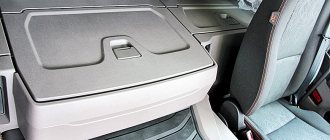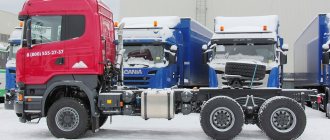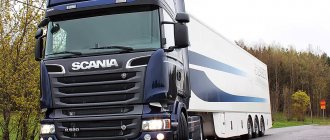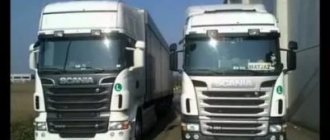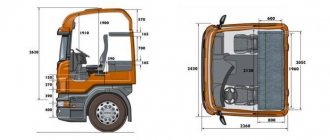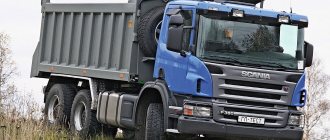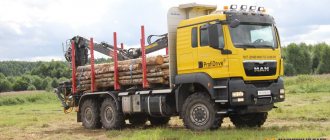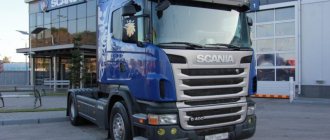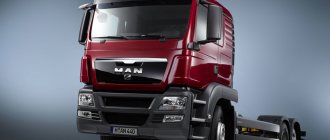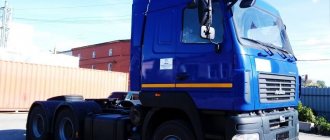Ask any boy what brands of big trucks he knows. Scania is guaranteed to be named in the top three. Even little freckled tomboys are fascinated by the smooth, unstoppable and powerful movement of the graceful Atlanteans.
They, little curious eyes, don’t yet know what the shiny V8 nameplate means? What's hidden under the hood and behind the large viewing windshield. The fuel consumption, payload and maximum speed of the Scania R730 V8 are also not yet known to them. Moreover, they have no idea how comfortable and thoughtful the interior of the Scania R730 V8 is.
The reflections of the sun or shy drops of rain, the measured rumble of a diesel engine or streams of dusty air cut by the cabin, or perhaps something elusive and inexplicable, evoke admiration and force the king of tracks and dirt roads to follow his gaze. The words Scania R730 V8 Streemline or Topline, still incomprehensible to young admirers, are passed on in lively conversations as secret and intimate knowledge.
Many Russian boys have not yet met this dear Swedish aristocrat on “their” roads. 155,000 euros – that’s how much a Scania R730 costs. But when they meet, they are ready to whisper “V8” after an invisible truck driver in the cabin of a Scania R730. These route liners are still more common in the vast expanses of Siberia. After all, it is in harsh operating conditions that the Scania R730 V8 shows its best qualities.
From Scania Regent to Scania R730 V8
Did the founders of Scania AB ever imagine that from 1890 to the present day, their car workshops on the outskirts of Södertälje, Sweden, would become one of the most iconic companies in the production of premium heavy-duty trucks? Maybe yes! How else can we explain that fifteen lei after the company was renewed in 1911, trucks with a closed cabin first appeared on the roads of Scandinavia, under the remote hood of which a four-cylinder diesel engine with valves in the upper part rumbled.
Another confirmation of Scania’s commitment to long-term success is the development by its designers in the mid-20s of the last century of six-cylinder outboard engines with a capacity of 100 hp. The invaluable experience of its own designers in the development and operation of outboard diesel engines strengthened Scania’s confidence in conquering the roads and the European market.
In the post-war years, all of Scania's own diesel engines with 4, 6 and 8 cylinders were brought to common standards. This made it possible to flexibly fulfill international orders and equip trucks for various purposes with engines with standardized parts and components. And here is the result:
- 1954 - Scania Regent receives the title of “most popular” among European truck drivers;
- 1969 – the DS engine with a volume of 14 liters and a power of 350 l/s was successfully tested;
- in the early 70s, an increase in the share of its own production of parts and tightening requirements for testing its trucks led the company to the creation of a V-shaped eight with a power of 375 hp;
- 2010 - having received applause for the “T” and “R” series in the previous decade, the company did not stop at 620 l/s and implemented the Scania R730 V8 project and overtook the MAN TGX with 680 “horses”.
- Low bow to the designers of Scania R730 V8
Scania R730 – from 4x2 to 10x4
The company's designers did not limit the “king of the roads” either in chassis or in comfort. As a result, the Scania R730 V8 can come off the production line with a different number of axles. If in Hannover at the IAA 2010 a version on a 4x2 platform was presented, then on the roads of the world air flows and clouds of midges are cut through by the Scania R730 V8 grille in 4x4, 6x4, 8x6, 8x8, and even 10x4 configurations.
Thanks to a wide range of frame choices, customers prefer to comfortably transport platforms with passenger cars, tanks with liquid petroleum products and bulk goods, platforms with containers, and vans with general goods. The company successfully tested the Scania R730 V8 with 13 axles and was able to demonstrate a record payload of 105 tons.
Any version of the platform has optimal weight among its analogues. This is achieved by a minimum number of parts, their rational arrangement and coordinated functionality of the units. The range of Scania R730 V8 modifications has a reliable towing mechanism that can withstand a load of 35 tons. The designers took care not only of the mechanical qualities of the tug, but also of the integrity of the attached cargo, which can be towed to the service center behind the faulty tractor.
Axle bearings with a large margin of safety, shock absorbers with pneumatic pumping, parabolic springs, a stabilizer on the front axle, all-wheel drive, ground clearance adjustment on the dashboard, a static stability control button before pressing the accelerator, a wheel speed control gearbox - all this, and more, makes the Scania R730 V8 a desirable draft horse in every garage.
Engine characteristics of Scania R730 V8
In its very name, the Scania R730 V8 model demonstrates one of the engine characteristics - 730 horsepower.
Engine, volume, l Diesel, 16.4 l engine's type V-shaped Number of cylinders, pcs. 8 Number of valves, pcs. 32 Engine power, l/s 730 Torque, Nm 3500 Rotation speed, rpm 1500 Fuel consumption, per 100 km, l 44 Supercharging Holzet Maximum speed, km/h 210 Fuel tank, volume, l 500 Transmission Automatic transmission Scania Opticruise, 12+2 But one should not assume that the versatile approach of the Scania R730 V8 developers is limited by the variability of platforms. The same variability is also present in the variety of engine groups that can be installed on the Scania R730 V8 model range. Don't forget that the Scania R730 V8 is a branded “bird”. Depending on the wishes of the customer, motors can have a herd power from 400 to 750 l/s. By the way, the most economical is the new generation of engines 410-580 l/s, where the exhaust gas recirculation system (EGR) and the injection system of synthetic ammonia into the exhaust mixture in a volume of 1.5 liters per 100 km (SCR) bring the average fuel consumption to 29 .4 liters (!) per 100 km of driving with pleasure. The company is already testing new engines using compressed and liquefied gases (CNG and LNG).
- Scania R730 engine hugging a turbine
It would not be superfluous to mention that the turbine is located directly in the center of the engine, at the base of the divergence of the heads, and the heads are divided by the pistons. This is a Södertälä classic. Repairing such a “strongman” does not cause problems for service centers, since many components and internal working parts of the engine have unified standards and there is no need to individually select, for example, a piston group for each engine. An oil change becomes extremely necessary only after reaching 60 thousand km.
If you need to look under the hood of the “king”, or rather under the driver’s seat, then to do this you need to fold back the front grille. It is under it that the manual pumping valve for the cabin tilting oil pump is located. These manipulations eliminate incorrect actions when tilting the cabin, serve as a reminder of safety measures and the urgent need to “ventilate” the turbine.
Transmission Scania R730 V8
The comfort and pleasure of driving such an Atlante is ensured by the Opticruise automatic transmission. Like the Scania R730 V8 itself, the embodiment of the fastest and most powerful production iconic truck, the automatic transmission is the eyes, ears and thoughts of the driver. Despite the automatic nature of gear shifting and the lightning speed of acceleration, to secure the driver’s actions, a lever for manually switching modes and gears is located on the right under the steering wheel. The robot box itself adapts to the conditions of the track.
Additional sensors, devices and mechanisms have a positive effect on the operation of the transmission in absolutely any conditions. For example, the longitudinal inclination sensor of the road surface (like in an airplane!) tells you when and which gear to select in accordance with the weight of the load and the speed of movement, in order to overcome a long climb as “easily” as possible or, conversely, carefully roll down, braking with drum brakes. The anti-slip system and the Retard system allow the robotic box to independently select maneuvering or power mode, and select the desired speed to overcome areas with a muddy dirt road.
The input shaft of the Scania Opticruise robot is under the constant control of a hydraulic retarder, which “rubs” with it in the same housing. The transmission not only thinks, drives and makes decisions, it also reports to the driver. It displays its every-second reports on the electronic display, which is located in the center of the dashboard, exactly between the beams of the steering wheel!
- Driver and Scania R730 V8 - heart-to-heart talk
To the satisfaction of current and future Russian drivers, the electronic display can be in Russian. Scania AB designers have done everything to ensure that the traditions of cooperation with Russia, begun in 1915, continue today!
Cabin Scania R730 V8
To even say that the Scania R730 V8's cabin is luxurious is an understatement. The designers followed the path of optimal necessity and comfortable functionality. Compared to previous Scania "R" series tractor models, the Scania R730 V8 has many external changes. This includes a grille spread across the hood, improved streamlining due to a change in the angle of resistance of the front part, a front part extended forward by 13.5 cm, a front bumper moved forward 8 cm, direction indicators outside the bumper, and protective trim on the headlights. with dirt cleaners, and a separate bumper mount, and stylish air intakes, and directional mirrors, and thin, durable A-pillars that do not reduce visibility. All these elements ultimately contribute to safety and driving comfort.
More on the topic: International Trucks: American Style
Scania R730 V8 Streamline, Topline, Highline, Longline
Particularly worth mentioning is the interior of the Scania R730 V8, like apartments on wheels for a truck driver. Leather ergonomic seats allow the truck driver to sit like in a car, with armrests and a control panel. Without changing your driving position, you can turn on the radio, open the windows or sunroof, and control the air conditioning.
High-quality plastic on the door panels, front panel and simple but reliable design of the folding table opposite the folding passenger seat. Soft, even light from the central ceiling lamp and the lamp on the visor, a steering wheel with wooden inserts (not every small car has such a steering wheel), curtains on the windows, pleasant-to-touch interior upholstery. Chic, and that’s all!
Cabin types
All Scania R730 V8 cab types are spacious and offer plenty of interior space. Compactly located in the canopy and front panel, a folding table, shelves, cabinets and a compartment under the lower berth accommodate a refrigerator with freezer, a microwave oven, and a coffee maker. Of course, these devices come with Scania Topline keys and are included in the price of the tractor. The constant height inside the cabin is 2.2 m, width – 2.13 m, depth from the windshield – 2.2 m. The lower berth with a width of 0.8 m is located at a height of 0.39 m from the floor and consists of a wooden structure with orthopedic lamellas. To climb onto the top shelf with a distance of 0.6 m from the ceiling behind the driver, a folding profile ladder is provided. Everything is thought out to the smallest detail in the simple and most comfortable Topline interior.
Topline cabin and interior dimensions
- Life inside Topline
- With all the similar signs of civilization and a two-meter length of shelves for rest, the overall height of the Scania Highline tilting cab is 0.32 m lower. Accordingly, all height parameters will be smaller compared to the Topline option. The upper orthopedic “bed”, when unfolded, almost rests on the headrest of the driver’s seat, but the height of 0.7 m between the shelves is sufficient for a comfortable rest.
Interior dimensions of Scania Highline
- It makes no sense to describe the interior of the Scania R730 V8 Longline cabin. This is the case when photos are better than words.
Scania R730 V8 Longline before tuning
- The Scania R730 V8 Streamline cabin is based on Topline and is equipped with a large number of external fairings, bumpers and deflectors, which not only push away visible and invisible flows and enhance aerodynamic characteristics. This is a cab model equipped with the maximum number of additional options related to fuel economy and services for the driver. Maximum speed and comfort with maximum savings - this is the motto of the Scania R730 V8 Streamline.
Options Scania R730 V8 Streamline
- The second generation of engines, in accordance with Euro-6 standards, saves up to 8% of fuel.
- The already very smart cruise control has been enriched with an economical mode.
- Electronic kits for monitoring the roadside area in front of the hood, monitoring brake control, navigation, remote diagnostics of the “health” of the truck with data transfer to the service center.
Everything is created for people, everything is created for work, everything is created for comfortable work of people on long-distance transport!
Matte chic interior of Scania R730 V8
Half a million on TopLine
All people are divided into optimists and pessimists, and while one half is racking their brains and afraid to make a decision, the others are working and gaining experience. With this report, the Trucker Blog begins a series of articles about people and machines. This is a world where some cannot exist without others, where there is freedom, which, although worse than bondage, still exists! A freedom that cannot be found working in the city, a freedom that intoxicates and opens up the world.
As a rule, behind every action there is a sober and cold calculation. The hero of my first report is truck driver Vladimir, who has been working intercity since 2003. After long negotiations, he agreed to answer my questions. The result was a short report about his car, Scania Topline. He traveled half a million kilometers on it. Yes, yes, exactly “passed”, because truckers, like sailors, do not drive, do not swim, but only walk. So to speak, some statistics first hand. All the most interesting things are under the cut, plus 20 photos.
As you know, a truck driver spends most of his life in the cab. And if he happened to get home, then rest assured that every day will be scheduled according to the hour. There are children and housework, which comes to a standstill while we are away from flights. The car also requires attention. After all, there is an iron rule: if you don’t want “surprises” on the flight, check and fix everything at home. And even though the loading was scheduled for tomorrow, Vladimir still devoted some of his personal time to me to share his experience with the readers.
White SCANIA 124 TOPLINE, 2004. This is Vladimir’s second car, the first car was an Iveco Euro Star tractor. But at the height of the 2009 crisis, I had to part with Iveka. Scania was bought in 2008, just at the peak of prices. At that time, for a five-year-old car they asked for two million three hundred thousand Russian money. The Schmitz trailer from 2004 cost another million rubles. By the way, the crisis has put many in their places. Almost half of the transport companies have ceased to exist. Our hero passed this fate, but at what cost it was best not to mention it out loud.
When purchased, the Scania's odometer showed 524 thousand kilometers. Today, three years later, the odometer is about to cross the million mark. All this time, Vladimir, alone, has been riding approximately the same route: the center of Russia - Siberia. On average, there are two flights per month to Novosibirsk and back.
I must say, the car showed its best side. For the entire time, not a single serious breakdown. When I started asking questions about what components and assemblies had been changed during this time, the owner seriously thought about it; all the repairs were planned.
The tractor required two sets of tires in three years. Rubber Bridge. Two sets were also carried on the trailer. The first was Kormoran, which honestly cost three hundred thousand, the second set turned out to be prefabricated, which is still on the trailer.
The radiator was removed and cleaned once. We rebuilt the cabin suspension; work with spare parts cost the service about twenty thousand rubles. Also, at the service center, the front suspension was recently rebuilt. The work was carried out for the first time since the date of purchase and cost a little less than fifty thousand rubles.
Nine hundred thousand were given a long life by the autonomous system. After this, a product from the domestic automobile industry was installed in the cabin. Samara, with a price difference with Western analogues of almost two times. Price including installation, approximately sixteen thousand rubles.
Batteries caused a lot of trouble. In three years, three (!!!) sets of batteries were replaced on the car. This is despite the fact that they did not buy the cheapest products from Western brands. I must say that battery failure is a fairly common occurrence.
Domestic roads are a topic for a separate expense item for every truck driver. In three years, Scania has replaced three headlights and one windshield. Although the costs fell on the shoulders of insurance companies, no one will return the time spent on repairs. I must say that annual hitch insurance costs about fifty thousand rubles. But it’s worth it, and according to Vladimir, he insured and will continue to insure the car. His personal statistics show a positive balance between payments and insurance premiums.
For diesel fuel, the situation is approximately this: twenty tons of cargo yields 36-38 liters of fuel per consumption. The load is less than seven tons - consumption is 29 liters. Let me remind you, Scania L124 420 hp. Fuel exclusively from branded gas stations, Gazprom and Omsky Oktan.
Over the entire period, two air springs were replaced on the tractor and three on the trailer. A set of shock absorbers on the tractor, and only one on the trailer. This is not fantastic, it is just the result of careful driving.
Most recently, the windshield wiper mechanism was replaced; branded spare parts cost ten thousand rubles. We replaced all consumable parts on the tractor saddle. Together with the work, the price is also about ten thousand.
The car is equipped with a retard, which could not but affect savings and consumables. Over half a million kilometers, two sets of brake linings on the front axle and one on the rear axle were replaced on the tractor. Over the entire period, the linings on the trailer were changed only once. All brakes are disc. This indicator, as a consequence, of driving style.
Maintenance and oil changes are carried out regularly every forty thousand kilometers. Shell oil, semi-synthetic. Working with consumables at the service costs approximately eleven thousand rubles.
In this version of the cabin, the best sleeping place is above the dashboard. Now in Scania, performed by Topline, the upper sleeping bag has moved to its original position, to the rear wall of the cabin.
Home-like, cozy and clean cabin. Everything you need on a long journey is at hand. A gas stove and dishes are hidden in the lockers. The refrigerator is stocked with food until the end of the flight. Vladimir said that lately he prefers to eat only home-cooked food, and what he prepares himself. The quality of food in roadside cafes, unfortunately, leaves much to be desired.
Unfortunately, on the day of our conversation it was pouring rain, so there were very few good pictures.
At the end of the conversation, we wished each other good luck. Vladimir is loading tomorrow. The route, as before, is Novosibirsk. A road where he knows every turn and every pothole.
Reviews of Scania R730 V8
Reviews about the “Bench”, as truckers call Scania, are very different, but among them there is no indifference. Many have noted the Scania R730 V8's excellent road-absorbing qualities, holding the road especially well with a load on its back. The curved instrument panel creates a feeling of complete control over the situation. The elegant steering wheel shakes from small irregularities, but stands rooted to the blows of changes in the road surface. In the cabin there is a slight creaking of the panel when there are distortions on the road.
Road control and tracking sensors prevent the robotic gearbox from making a mistake when choosing a gear on the snowy roads of Russia. Truckers call the Opticruise gearbox “intelligent” for its softness and precision of switching and the ability to “stretch” a long climb at 65 km/h. You can switch to manual mode by simply pressing the end key on the box control lever. The insightful Scania R730 V8 anticipates the driver's actions.
In their reviews, drivers often compare the Scania R730 V8 with the MAN, and most comparisons are far from in favor of the latter. There are many complaints about service centers and the quality of service, but with careful selection of personnel for long-distance transportation, many breakdowns can be avoided.
Source
